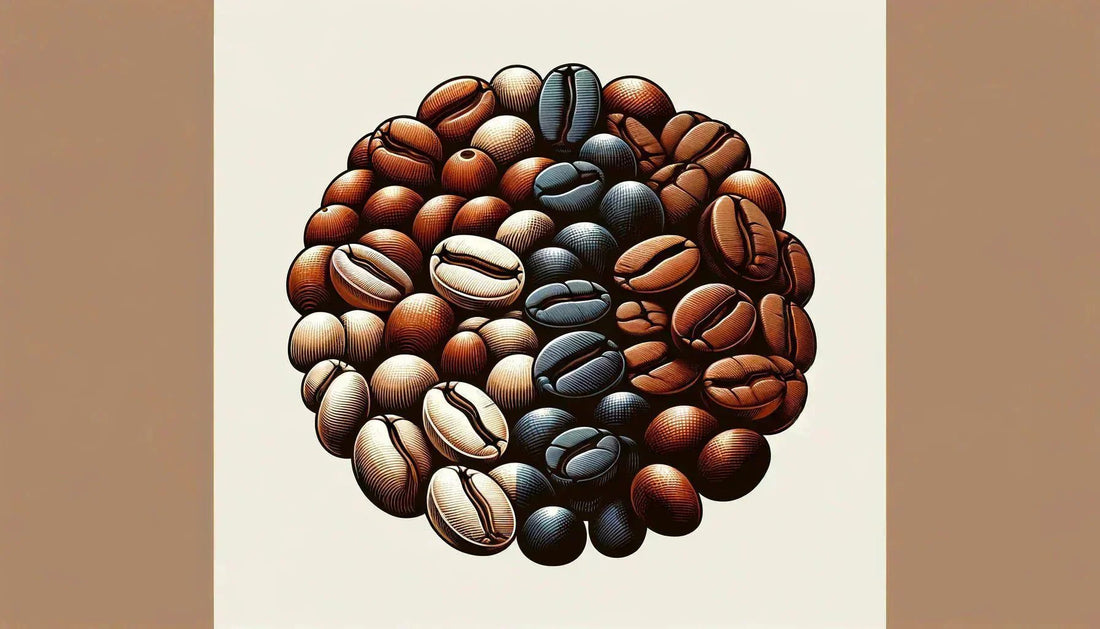How much caffeine is really in your coffee? Well, it varies quite a bit. In fact, the roast level has only a minor effect on the caffeine content. What's more important is the type of coffee, how you brew it and the size of the serving. Read on to find out what affects the amount of caffeine in your coffee.
What is Caffeine?
Caffeine is a natural stimulant found in coffee beans, tea leaves, and various other plants. It’s what gives you that extra energy when you have your morning brew. But not all coffees contain the same amount of caffeine. There are several factors that influence how much caffeine ends up in your cup, including the type of bean, the roast level, and the brewing method.
Types of Coffee Beans: Arabica vs. Robusta
Let’s start with the actual beans. There are two main types of coffee beans: Arabica and Robusta.
- Arabica beans are the most popular, making up about 60-70% of the world’s coffee production and are well known for their smooth flavour. They generally have lower caffeine content, ranging from 1.2% to 1.5% by weight.
- Robusta beans have a stronger, more bitter taste and contain higher caffeine levels, about 2.2% to 2.7% by weight. This higher caffeine content acts as a natural pest deterrent for the plant.
So Robusta might be the type of bean to choose if you like to experience that stronger kick!
Roast Levels: Light, Medium, Dark
You might think darker roasts have much more caffeine because of their bolder flavour, but that’s not entirely true. The way it is roasted has an impact on the amount of caffeine in your coffee but not as much as you think.
Why? Caffeine is a complex molecule that is neither created nor destroyed in the roasting process. Every individual bean contains the same amount of caffeine after roasting as it did before, mainly because the temperature at which coffee is roasted tends to be lower than the temperature at which the caffeine molecule breaks down.
So how can there be a variation in the caffeine content of coffee? Well, as coffee is roasted, each bean becomes less and less dense and therefore lighter. So the caffeine to weight ratio is slightly higher for darker roasts than light roasts.
Here’s a quick breakdown:
- Light Roast: Retains more of the coffee bean’s original characteristics with slightly lower caffeine per gram of coffee.
- Medium Roast: A balanced roast that maintains a good amount of caffeine while offering a more complex flavour profile.
- Dark Roast: Has a bolder flavour and slightly more caffeine due to the longer roasting process - the beans themselves lose weight, but not caffeine, the longer the roast goes on.
Despite these differences, the variation in caffeine content between roast levels is really very small. The way you brew your coffee has a much bigger effect.
Which Brewing Method Contains the Most Caffeine?
Different brewing methods extract caffeine from coffee beans in various ways. Here is a list of the most popular methods and how much caffeine is typically extracted for each...
Espresso
A single shot of espresso (about 30ml) contains approximately 63mg of caffeine. While this seems high, remember that a typical serving size is smaller than other methods.
Filter or Drip Coffee
When it comes to determining the amount of caffeine in filter or drip coffee, the brewing method plays a key role.
Filter coffee is made by pouring hot water over coffee grounds housed in a filter. The water seeps through the grounds by gravity and not by pressure, as seen in other brewing methods.
This method allows for thorough extraction of caffeine because the water remains in contact with the coffee grounds for an extended period.
A standard 230ml cup of filter coffee generally holds about 145 mg of caffeine. However, the content can range from approximately 115 to 175 mg depending on factors such as the coffee bean type, grind size, water temperature, and brewing time.
This variance highlights why filter coffee is favoured by those who prefer a stronger amount of caffeine their morning cup.
French Press or Cafetiere
Similar to drip coffee, a 230ml cup from a Cafetiere typically contains around 80 to 135mg of caffeine. Again, this depends very much on how long it's brewed for.
Cold Brew
This method involves steeping coffee grounds in cold water for an extended period (up to 24 hours). As a result, it tends to be very concentrated, with about 200mg of caffeine per serving (230ml).
How Much Caffeine is there in Lattes and Cappuccinos?
If you've ever wondered about the caffeine content in your favourite coffee drinks like lattes and cappuccinos, the answer lies in the espresso shots they are made with.
These popular coffee drinks, along with others like macchiato and mocha, are essentially variations of espresso mixed with differing amounts of milk. Therefore, the caffeine content remains largely dependent on the number of espresso shots used in the cup.
Typically, a single espresso shot contains approximately 63 milligrams of caffeine. So a coffee drink made with one shot of espresso, such as a standard latte or cappuccino, would contain that amount of caffeine.
However, if you prefer a stronger brew, using a double shot in your latte or cappuccino will give you about 125 milligrams of caffeine. Hence, the caffeine content in these espresso-based drinks can be varied based on the number of shots you'd prefer to use.
Understanding this will help you better manage your caffeine intake while still enjoying your favourite coffee drinks.
Does Decaffeinated Coffee Contain Caffeine?
Decaffeination Process and Its Effects
Decaffeinated coffee undergoes a process designed to remove most of the caffeine. This is typically achieved through techniques like water washing, organic solvent treatment, or carbon dioxide filtering, one popular method being the Swiss Water Process. Through these methods, about 97% of the caffeine is removed.
Residual Caffeine Content
However, the key point to understand is that decaffeinated does not mean caffeine-free. A typical cup of decaffeinated coffee still contains a small amount of caffeine, ranging typically up to 7 milligrams per cup. On average, you might expect about 3 milligrams per cup, though this can vary. The variance depends on factors such as the coffee bean type used, the decaffeination technique employed, and even the size of the cup served.
In summary, while decaffeinated coffee is significantly lower in caffeine than its regular counterpart, it does indeed contain caffeine, albeit in much smaller amounts. If you're sensitive to caffeine or monitoring your intake, it's worth noting that decaffeinated coffee isn't an entirely caffeine-free option.
How Much Caffeine is in Instant Coffee?
Instant coffee offers a convenient and quick alternative to traditional brewed coffee.
The process involves freeze-drying brewed coffee into granules that simply dissolve in water, eliminating the need for brewing. One cup of instant coffee typically contains between 30 to 90 milligrams of caffeine. This variance can depend on the brand and the concentration of the coffee used in the manufacturing process.
Therefore, it generally has less caffeine compared to regular coffee due to its unique preparation methods.
Fun Facts and Figures
- Did you know that in the UK, the average person drinks about 2 cups of coffee per day. This statistic reflects the growing coffee culture in Britain, where around 98 million cups of coffee are consumed daily. This significant figure underscores the popularity of coffee in the UK, which has seen a substantial increase over the years. That's about 200mg of caffeine per adult (if you exclude all the tea drinking us Brits do!) source: British Coffee Association
- According to the FDA in the USA, 400mg of caffeine per day (roughly four cups of coffee) is considered safe for most adults.
References and Further Reading
For those who want to dive deeper into the science of caffeine, here are some resources:
- National Coffee Association USA: Provides detailed information on coffee beans, roasting, and brewing methods. NCA Coffee Facts
- FDA on Caffeine: The FDA's guidelines on caffeine consumption and safety. FDA Caffeine Info
So, there you have it! The next time someone asks, "How much caffeine is in coffee?" you’ll have the answer ready. Whether you prefer the smooth taste of Arabica, the stronger effect of Robusta, or a specific brewing method, understanding these factors can help you tailor your coffee experience to get just the right amount of caffeine.


